|
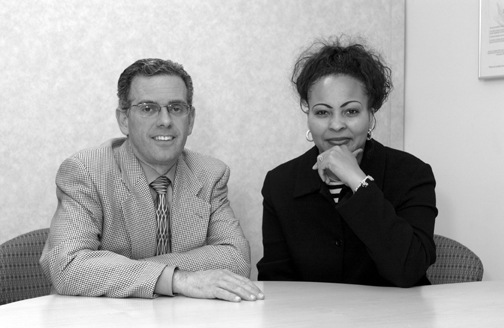
Dr. Fred Ognibene serves as director and DeNedra McPherson as deputy
director in the new Office of Clinical Research Training and Medical
Education. |
New office to benefit future research trainees
Future waves of clinical investigator trainees will benefit from the
Clinical CenterÕs new Office of Clinical Research Training and Medical
Education. Rapid growth in the need to expand clinical research training
opportunities at the Clinical Center, and for NIH intramural scientific
research programs in general, spurred establishment of the new Office.
The Office will centralize many of the existing research training and
medical education functions and emphasize the organization's commitment
to developing a cadre of well-trained and highly-skilled physician-scientists.
"It is my hope that this Office will review and improve as necessary
our existing curriculum for clinical research training that will be available
to clinical investigator trainees coming to NIH. In addition, I hope this
Office will assist the NIH institutes and centers in improving their clinical
research training programs as appropriate," said Clinical Center
Director Dr. John Gallin.
Programs and services offered by the Office will have a direct impact
on improving how clinical research is conducted. For example, formal coursework
in clinical research principles as well as the opportunity to undertake
formal master's level training in clinical research will allow the next
generation of physician-scientists to gain these skills in addition to
their skills as translational, or bench-to-bedside, investigators. The
programs and services will primarily target NIH physician-scientists seeking
to enhance their existing skills through academic training in clinical
research skills. In the future efforts will, when appropriate, bridge
to the extramural science community as in the case of federal non-NIH
scientists who have enrolled in the current clinical research training
courses and the education partnerships that exist with academic institutions
and major medical centers.
These skills must be formally taught and conveyed to the investigator
trainees according to Dr. Fred Ognibene, new director for the Office of
Clinical Research Training and Medical Education. "It is incumbent
upon us to do this not because we have to but because it is the Clinical
Center's public obligation to ensure that investigators are properly trained
in these principles in a comprehensive and ethically-sound manner,"
he said.
Ognibene's own road to his new position is one of long-standing involvement
and leadership in clinical research education, training and mentorship
at NIH. He came to the agency as a clinical fellow, and then became a
Senior Investigator in the Clinical Center's Critical Care Medicine Department
where he was both a primary researcher and mentor leading the Critical
Care Medicine Fellowship Program. Until May 1 of this year he was co-chair
of the NIH Graduate Medical Education Committee for clinical fellows in
accredited training programs. In addition to his new duties, he will continue
on as Director of the NIH Clinical Research Training Program for medical
and dental students and attending physician in the Clinical Center's Critical
Care Medicine Department.
He sees his position in the new Office as leading the effort to better
educate "our physician-scientists through both an instructive and
practical approach" and for himself professionally as "another
step in building on his clinical research background."
The current focus of the new Office will continue to be the administration
of existing courses and training programs sponsored by the Clinical Center
including, the Introduction to the Principles and Practice of Clinical
Research, the Principles of Clinical Pharmacology, the NIH-Duke Training
Program in Clinical Research, the University of Pittsburgh Training in
Clinical Research Program, the required web-based Clinical Research Training
course, and the annual orientation program for new clinical fellows. "These
offerings work in concert to complement other training opportunities such
as the Ethical and Regulatory Aspects of Human Subjects Research course
sponsored by the Clinical Center Department of Clinical Bioethics,"
said Dr. Ognibene
DeNedra McPherson will serve as Dr. Ognibene's associate as the Deputy
Director for the Office of Clinical Research Training and Medical Education.
Her scope of responsibility is operational. She will be working with implementation
of the new Office and its related activities such as new collaborations.
Her NIH experience is a natural fit. "My career at NIH started in
the Intramural Research Program's Office of Education in the mid-nineties
when the Introduction to the Principles and Practice of Clinical Research
course initially began. The first class had 25 students. We now average
more than 300 registrants annually and approximately 3,000 students have
taken the course to date," she said. McPherson was also integrally
involved in bringing that program and others to fruition, with some now
having both a national and international reach with offerings taught in
an array of geographic locations such as Phoenix, Ariz., Honolulu, Hawaii,
San Juan, Puert Rico, and Buenos Aires, Argentina.
The impact of the Introduction to the Principles and Practices course
is now truly global as noted by Dr. Ofelia Rodriguez Nievas of Argentina.
"Our research organization has been honoured to act as a bridge between
NIH and local participants here. This was a great chance for many Argentine
colleges to learn and to become familiar with the clinical research world
through excellent lecturers who shared their knowledge with all of us.
I celebrate NIH policy regarding the opportunity given to us and to many
other countries, in offering these courses and facilitating the continuing
training on health issues," she said.
Building a robust portfolio of programs and offerings to provide the
necessary knowledge transfer to train future clinical scientists is the
main goal–and the new Office of Clinical Research Training and Medical
Education is up to the challenge.
–-by Dianne Needham
Back
to Top
The Clinical Center kicks off a year-long celebration of the 50th anniversary
of its opening on July 9 with a program and reception for employees and
patients. The program will be held in Masur Auditorium from 1-2 p.m. A
reception will follow from 2-4 p.m. on the south lawn outside the B1 Dining
Center. The celebration will continue on Oct. 14 with an all-day scientific
symposium in Masur and an evening gala. The events will conclude with
the dedication of the Mark O. Hatfield Clinical Research Center in summer
2004. In addition, a special 50th anniversary series of Clinical Center
Grand Rounds will run from Sept. 2003-June 2004.
Back
to Top
CRC landscape concentrates on functional beauty
View of the new entrance to the Clinical Research
Center.
|
To the casual observer, the new Clinical Research Center or CRC will
be nestled in amongst the trees, grass and gardens. In fact, though it
may seem to rise from the landscape itself, everything is being planned
with meticulous care to ensure privacy while creating a relaxing setting.
Two interior courtyards appear to be cement, but within months dirt
will be laid, shrubs and trees planted and two fountains installed. "In
a real sense, it's the type of landscaping that works its way in,"
said Don Sebastian, project officer for the CRC. "On the regions
further out, it's a typical layout with trees along the roads. Further
in, it serves a more functional purpose."
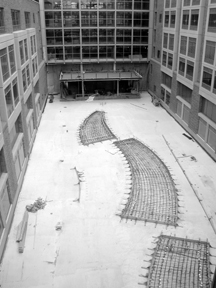
One of the two inner courtyards to the CRC now is cement. Dirt,
trees, bushes, and a fountain will create a serene and private environment
for patients and visitors. |
Sebastian says that the design will discretely keep people away from
the building, ensuring the privacy of patients. The children's area will
be fenced, but the fence, he added, will have hedges. These hedges will
be nice and kind of prickly to keep people out, but will keep the fence
from having an institutional look. In the two inner courtyards, patients'
windows line both sides. Bushes will extend to the window sills, and trees
beyond will be above the sills. All this, he said, will give the feeling
of being "out in the open," but maintain privacy for patients
in their rooms and for patients and visitors in the courtyards.
"Only on the first floor will this be a concern," he explained.
"Patients on the third, fifth and seventh floors, will be looking
down on the landscape and not through it." Visitors to the CRC site
now see only construction and dirt. Bulldozers sweep the area and workers
in hardhats labor steadily both inside and out. Sebastian refers to a
photocopy of the blueprint and points determinably to a work in progress.
What he sees now may be only in his mind's eye, but he seems to see it
as if it were there.
Will it look as breathtaking as it sounds? "I hope so!" he
said.
Back
to Top
New patient information packet available
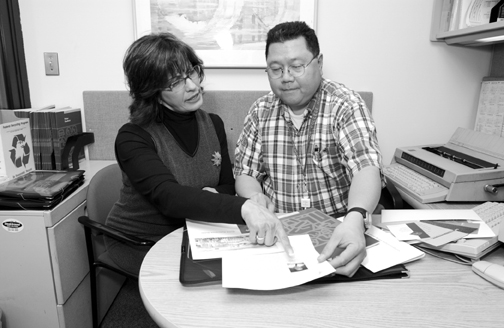
Steve Yen, admissions clerk,
and Wanda Malave, program/management analyst, Ambulatory Care Services,
review the contents of the new patient information packet.
|
Patients now have a better way to carry the information
they receive in Admissions. New Clinical Center patients will receive
all their information in sturdy, plastic folders. The folders have ample
room for the patient handbook, informational pamphlets, shuttle schedules,
maps, and telephone numbers so crucial for new patients and their families.
For many patients, the Clinical Center is a large and confusing
place. "There is a great deal of information we provide new patients
on their first visit to the Clinical Center and identifying what is most
critical to remember can be very overwhelming," says Karen Kaczorowski,
chief, Ambulatory Care Services.
Knowing that this was common to new patients, Clinical Center
leadership responded by organizing key information into one packet.
"Dr. Gallin [Clinical Center Director] believes that
we have to listen to our customers to continually identify opportunities
to create a strong patient-centered culture. We received feedback from
the Patient Advisory Group that there needed to be more information about
resources outside the Clinical Center. Sometimes it is hard to be in the
right place at the right time. Just knowing who to ask for directions
would help tremendously," said Deborah Gardner, chief, Office of
Planning and Organizational Development.
"Having just completed the Clinical Center-wide customer
service training, Karen and I perceived this as an opportunity to improve
the first experience patients have with the Clinical Center admissions
process," continued Gardner." We wanted to keep the focus on
patient satisfaction."
And what better way to establish stronger rapport with patients
than to provide them with a welcoming, organized folder of essential information?
The existing patient handbook, while thorough, was not physically able
to hold all the documents patients need as soon as they were admitted.
Based on information collected from patients, senior management and department
heads, the new patient packet was developed.
The folder holds the patient handbook, two separate envelopes–one
for key hospital information and one for key local resources–and
a quick reference guide, together with a welcome letter from Clinical
Center Director Dr. John Gallin.
Wondering about some of the services available at the Clinical
Center? Open the "Hospital Information" envelope to find publications
such as Your Patient Representative, Partners in Research and Bioethics
Consultation Service at the NIH.
Searching for a Metro schedule? Just flip open the envelope
entitled "Local Area Information." This pouch also contains
brochures such as a guide to eateries in Bethesda, and other sites in
the Washington area.
Local and Clinical Center maps, cafeteria hours, detailed
shuttle schedules to local hotels and motels and parking information are
found in the "Quick Reference Guide."
"We feel the patient information packet impresses
upon the new patient how organized and prepared we are to receive them,"
said Steve Yen, admissions clerk.
Kaczorowski is justifiably proud of the Admissions staff's
abilities to establish the caring rapport patients need as soon as they
arrive. To enhance their skills, the Admissions staff received a one-hour
training session to acquaint everyone with the materials in the packet.
It also reinforced the message that a "golden triangle" of support,
consisting of the Admissions staff, Patient Representative Laura Cearnal
and the Hospitality staff is provided by the Clinical Center exclusively
for patients and their families.
"Patients need to know that they are welcome and have
a support system right from the start," said Gardner.
Support is the message this packet will help convey. By
coming to the Clinical Center, patients make a tremendous commitment to
clinical research. The new patient packet will be another way the hospital
can say "thank you" for being part of the nation's quest for
health and knowledge.
–by Wendy L. Schubert, Sc.M
Back
to Top
Gladden receives 2003 Hemapheresis Specialist
Award
DeCarlo Gladden, R.N., Blood Service Section, Department of Transfusion
Medicine, has been awarded the 2003 Society of Hemapheresis Specialists
award by the American Society For Apheresis.
The award is given to individuals who have shown a dedication to the
field of Hemapheresis and who have emerged as leaders among their peers.
"This award really says something about the people I work with,"
said Gladden. "The staff should share in this award, because I could
be the best in the entire world, but if the staff doesn't work well together,
then it means nothing."
Gladden received the award last month during the ASFA annual meeting
held in Lake Tahoe, Calif., where she facilitated a workshop. The ASFA
provides educational programs in apheresis designed for physicians serving
as medical directors of blood donation centers, therapeutic and stem cell
collection facilities and practitioners of transfusion medicine.
"DeCarlo Gladden is one of the most compassionate, skilled, technically
outstanding, yet sensitive nurses I have ever had the privilege to work
with," said Dr. Susan Leitman, chief, Blood Services Section, Department
of Transfusion Medicine. "She is not only knowledgeable, she is also
enormously kind, gentle, diplomatic, and tactful. She leads by example,
keeping morale high and causing others to work efficiently and to their
fullest capacity. She is truly a leader in her field."
Gladden came to the Clinical Center in 1993 and since then has emerged
as a leader. She serves as a team leader for her section and a liaison
between lead protocol investigators, protocol coordinators and her staff.
She refers to herself as an orchestra leader in the department. "There
are so many talented people and each of them has a special gift. I simply
blend their talents in a way that will benefit the unit and maximize the
workload."
Additionally, she aims to keep morale up by frequently recognizing the
work that the staff performs. "The staff is not expecting constant
praise or recognition for their work efforts and contributions to the
department, but I feel they've worked hard and it's justly earned. They
always give 110 percent and I want them to know it's appreciated."
Back
to Top
'Everything guy' retires after 20 years of federal
service
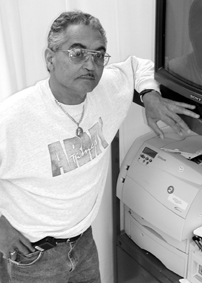
Jim Gray
|
Materials Management specialist Jim Gray describes himself as a "Do
Everything Guy"–and it's easy to believe. In 1981, he retired
from the U.S. Army with 20 years of service, and is retiring again after
another 20 years of gainful federal employment. This time, he says, he
intends to get some rest and relaxation.
"I'm just going to sit around for awhile and relax," he said,
adding that he may find work as a bartender three or four days a week.
"Maybe I'll work the happy hour. That's something I'd enjoy because
I like people."
In fact, the most memorable part of his job, he said, is helping people.
"Not only patients, but anyone–and to help them in any way humanly
possible. "If something needs to be moved, or someone needs directions
or a patient needs a candy bar, "that's what I'm there for."
He also provided special equipment for patients and prepared isolation
rooms and helped prepare equipment for cataloging. Gray didn't waste time
after his retirement from the Army. "I retired on Feb. 28 and on
March 1, I was in Saudi Arabia." His job was a three-year logistics
contract for the U.S. Navy instructing the Saudi navy. "I loved it,"
he says. "Beautiful people!"
In 1985, he returned to the U.S. to work for the Navy's prestigious David
W. Taylor Research Center in Bethesda, Md. For 28 days he was a security
guard and a supply clerk; then he landed a job in the metal shop as an
expeditor. In 1989, he got a bachelor's degree in Supply at College Park
and began work that year at Children's Hospital, Washington, D.C. In 1991,
he began working at the Clinical Center.
"After 20 years in the Army and three years in Saudi Arabia, there's
no culture shock in going anywhere in the world," he said. "I
don't know where I'll end up, but I love people, so it doesn't make any
difference to me where I go."
Back
to Top
Nurses saluted for maintaining the nation's health
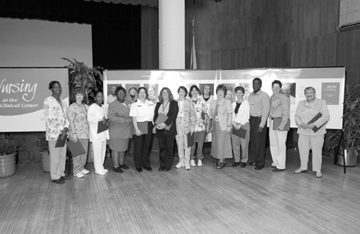
(Right) Tannia Cartledge, MS, RN, Chief of Adult,
Pediatrics and Behavioral Health, Nursing and Patient Care Services
participated in the ÒCelebration of NursingÓ opening program. (Top)
Peer-nominated "Outstanding Nurses" were recognized during National
Nurses Week.
|
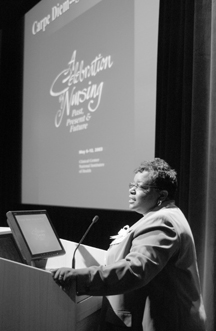 |
Across the United States, nurses were saluted in May for their dedication,
commitment and tireless efforts in promoting and maintaining the health
of the nation. There are nearly 3 million registered nurses–the largest
health care profession–in the U.S. and more than 1,000 work at the
Clinical Center, both within the Clinical Center and in NIH institutes
and centers.
Nursing at the NIH Clinical Center hosted "A Celebration of Nurses–Past,
Present and Future," during May 6-12 with events throughout the week.
Special activities included an opening program, reception and recognition
of outstanding nurses, a Florence Nightingale birthday celebration, and
scientific research presentations and posters.
Back
to Top
Palsgrove retires after a fun-filled 30 years
of service
Mary Palsgrove has had more excitement in her 30 years of government
service than most people have had their entire career. Even after she
retires this month she is hoping to continue her fun times.
"During the past 30 years, I have met some really fascinating people
from all over the world," said Palsgrove. "NIH is a good place
to work. It's a melting pot of all nationalities and I've learned a lot
about different countries, their customs as well as their cuisine."
Palsgrove began her government career in 1963 as a secretary with the
National Geographic Society. By 1966 she took a position at the Department
of Agriculture in Hyattsville, Md. and left two years later to become
a full-time mother of two children.
After a six-year hiatus, she went to work for the National Oceanic &
Atmospheric Administration and the Department of Defense. It wasn't until
1986 that she came to NIH. "While working at NIH, I made a major
change in my lifestyle," said Palsgrove. "I started running
for the first time in my life." She began to enjoy running so much
that she ran in the 5-mile Parklawn Classic Race, which she won for three
consecutive years.
By 1991, Palsgrove stepped out of the secretary series when she accepted
a position with the National Institute of Alcohol Abuse and Alcoholism
as an administrative assistant. She continued in that series with the
National Institute of Child Health and Human Development in 1992. There
she met Chelsea Clinton who came to work in one of the laboratories for
a short time, Vice President Al Gore and wife Tipper, and Senator Ted
Kennedy. Palsgrove also met Fergie, the Dutchess of York in 1995 while
working in the Clinical Center Director's Office.
"I don't believe many people have had this much excitement while
working at NIH," she said.
Palsgrove's last stop at NIH was with the Clinical Center's Materials
Management Department where she worked as a program analyst. She will
retire on June 27.
Aside from working at NIH, Palsgrove has also been active with the Noontime
Christian Fellowship and served on the National Day of Prayer committee
for the past eight years.
"It is with great joy that I'm looking forward to my retirement,"
said Palsgrove. She and her husband are building a house on the northern
neck of the Potomac River in Virginia and plan to boat, golf and travel
to Europe. She said she plans to continue her hobbies of silversmithing
jewelry, hand painting silk and sewing.
"God is good because my years here have been satisfying. Although
it is sad having to leave all of my friends, I'm grateful for the opportunity
and experiences I've had while working here."
Back
to Top
NIH
Fire Marshal team: Fighting fires before they start
When J.P. McCabe was 16, he learned that the University of Maryland had
an accredited program in Fire Protection Engineering. So he arranged a
meeting with the chairman of the department and, in so doing, set the
course for his future career.
McCabe, now a registered fire protection or FP engineer, is the NIH Fire
Marshal. Located in a modest residential house on the north end of campus,
he manages four very busy–but rarely harried–assistant fire
marshals. All are dedicated to the cause of fire protection and prevention
with a fervor that reflects their roots in firefighting.
The firehouse includes federal FP inspectors who are assistant fire
marshals and four FP engineers, who also happen to be University of Maryland
graduates.
"We're unique, because we have FP engineers and inspectors, all
under one roof," McCabe said. Usually these disciplines are divided
into two distinct groups in federal, state, county, and private sectors.
We do everything out of this office." He adds that each inspector
and engineer in his office has received training through the University
of Maryland Fire and Rescue Institute training program, including his
deputy Sam Denny.
Denny became a volunteer firefighter at age 16 in Johnstown, Penn., along
with six friends who initially just stopped by the firehouse to see what
was going on. He now has a volunteer position as deputy chief of Prince
George's Chillum-Adelphi Fire Department, Langley Park, Md.
Among the fire marshal's duties are construction monitoring, including
the building of the Clinical Center's Mark O. Hatfield Clinical Research
Center; plan reviews, construction inspections, inspections of existing
facilities, public fire-safety awareness training and specialized training
for the NIH community, including the Clinical Center's nursing staff.
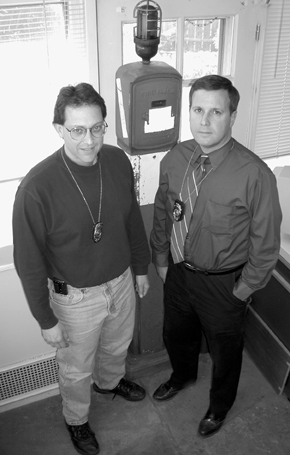
Deputy Marshal Sam Denny (left) stands with Fire Marshal J.P. Mc Cabe.
|
"We train all the patient care units, each staff member each quarter,
each shift," said Denny. "We also train all the Clinical Center
departments dealing with patient care at least once annually." They
also provide instruction for maintenance and housekeeping staff. That
alone, he added, keeps everyone very busy. The primary obstacle McCabe,
Denny and their team must overcome is complacency. Their goal for those
they instruct is to practice what the team preaches. They also perform
announced and unannounced drills at the Clinical Center, something McCabe
and his people know burden busy staff members. Fires don't announce themselves
in advance," he said, "and that's why we have unannounced drills."
The Fire Marshal team concentrates on fire prevention, trying to ensure
there are no fires from which to flee. Their tools are public education
and technology: intelligent fire alarm systems, smoke detectors, fire
retardant and fire resistant materials and, at the very core of fire protection,
automatic sprinklers.
"Many people think if sprinklers are activated, they're going to
flood someone's room or harm the person's operations in some way,"
McCabe said. He often asks people with that concern, "Which would
you prefer, 100-250 gallons of water a minute delivered with a fire hose
or a sprinkler head delivering a little over 20 gallons a minute at the
onset?"
In an actual fire, the fire alarms would sound only in the area of the
fire, thanks to new, zoned fire alarm systems. While firefighters respond
to assist, nurses and medical staff will close doors and evacuate patients
in a quick orderly process. They've been trained and retrained by the
assistant fire marshals.
"Our biggest report card is when the Joint Commission the Accreditation
of Healthcare Organizations comes every three years to survey the Clinical
Center," McCabe said. "They randomly question staff on routine
matters regarding fire safety." During the last several surveys (one
survey every three years), the NIH Fire Marshal's Office received exemplary
ratings. "When this happens," McCabe added, "I like to
pat my entire staff on the back because theyÕre doing great work."
Currently, the FP inspectors and engineers are working on fire alarm
system testing for the Mark O. Hatfield Clinical Research Center, in the
late stages of construction. During the last several months before dedication,
he and his staff "will be practically living in that building,"
he said.
Every fire alarm device throughout the Clinical Center will have a code
that's part of an addressable system, said Denny. "When a smoke detector
activates, when a manual pull station is activated or a sprinkler system
water flow switch goes off, it will be identified by a central fire alarm
receiving system in Bldg. 31 and immediately relayed to the NIH Fire Station
while the severity and spread of the fire is monitored by the fire alarm
system."
"It's a smart system," McCabe said, "with state-of-the-art
technology. And it's one of the largest addressable fire alarm systems
in the country."
The NIH Fire Marshal's Office, despite the hectic schedules of the staff,
is available to appear at special campus and community events "When
we're children, we're receptive to training and know what to do in a fire-emergency,
but as we grow older, many of us become complacent. We don't think it
can happen to us," said McCabe.
Contact the NIH Fire MarshalÕs Office at 301-496-0487 or visit www.nih.gov/od/ors/dps/emb/fps/
index.htm.
–by John Iler
Clinical Center online
Wireless Computing
In the past three years the demand for wireless computing
at the Clinical Center has grown tremendously. A program was initiated
in April 2000 to satisfy this need. The program has four phases: pilot
project, then phasing the following areas into a wireless network–high
priority nursing units, rewiring of existing hardware/new patient care
units and the office of the director; and outpatient areas. Since completing
the first three phases in May 2001 the wireless effort has been expanded
to many other locations in the Clinical Center including conference rooms,
offices, cafeterias, and auditoriums. Many employees from different NIH
institutes or centers use the network while visiting patients or attending
meetings. Wireless security for the Clinical CenterÕs wireless network
includes encryption, authentication, a firewall, and a secure gateway.
Due to the demand for wireless networks at NIH, the NIH Center for Information
Technology or CIT has initiated a wireless consolidation group consisting
of one representative from each institute or center. The goal of this
group is to develop standards and requirements for consolidating all wireless
networks into one wireless network managed by CIT. All current wireless
equipment on campus will eventually be turned over to CIT for management.
For more information on the Clinical CenterÕs wireless network, contact
Kelly Neadow at kneadow@cc.nih.gov.
Updated Web Information
The 2003 Clinical Center Strategic and Operating Plan is
now online at: http://www.cc.nih.gov/ccc/OD/strategic/sop03.pdf.
The Plan provides the goals, objectives and strategies for the Clinical
Center in 2003 and beyond. For further information on the Clinical CenterÕs
planning and organization development, contact Deb Gardner at dgardner@cc.nih.gov.
The 2003 Clinical Center Profile is now online at: http://www.cc.nih.gov/ccc/ccprofile/index.html.
The publication provides an annual report of the Clinical Center's 2002
activities. For further information on the Profile, contact Pat Piringer
at ppiringer@cc.nih.gov. Readers are
encouraged to share news items and ideas for Clinical Center Online. Email
dneedham@cc.nih.gov.
June
calendar
|
|
4
Grand
Rounds
noon-1 p.m.
Lipsett Amphitheater
Emerging Strategies: Treatment with Hereditary
Disorders Involving the CNS Roscoe O. Brady, M.D., NINDS
Novel Strategies To Prevent Ventilator-Associated Pneumonia
Lorenzo Berra, M.D., NHLBI
Wednesday
Afternoon Lecture
3 p.m.
Masur Auditorium
Cancer Drugs and On/Off Switches In Protein Kinases: Structural
Studies on the Specificity of the CML Drug STI-571/Gleevec
John Kuriyan, Ph.D., University of California, Berkeley
|
11
Grand
Rounds
noon-1 p.m.
Lipsett Amphitheater
Brain Strain: Perplexing Cases of Infectious Diseases
John Bennett, M.D., NIAID
Wednesday
Afternoon Lecture
3 p.m.
Masur Auditorium
Laureate Lectures for the Kettering, Sloan, and Mott Prizes for
Cancer Research General Motors Cancer Research Foundation: 2003
Scientific Conference
18
Grand
Rounds
noon-1 p.m.
Masur Auditorium
SARS: A New Challenge to Global Health Anthony Fauci, M.D.,
NIAID
|
25
Grand Rounds
noon-1 p.m.
Masur Auditorium
Death From Burning Fat: Too Little, Hypoglycemia; Too Much, Ketoacidosis
Daniel Foster, M.D., University of Texas, Dallas
|
Back
to Top
Editor:
Tanya C. Brown
Contributing
writers: Colleen Henrichsen, Dianne Needham, John Iler
|
|
Clinical Center News, 6100 Executive Blvd., Suite 3C01, MSC 7511,
National Institutes of Health, Bethesda, MD 20892-7511. Tel: 301-496-2563.
Fax: 301-402-2984. Published monthly for CC employees by the Office
of Clinical Center Communications, Colleen Henrichsen, chief. News,
article ideas, calendar events, letters, and photographs are welcome.
Deadline for submissions is the second Monday of each month
.
Back
to Top
|
|

